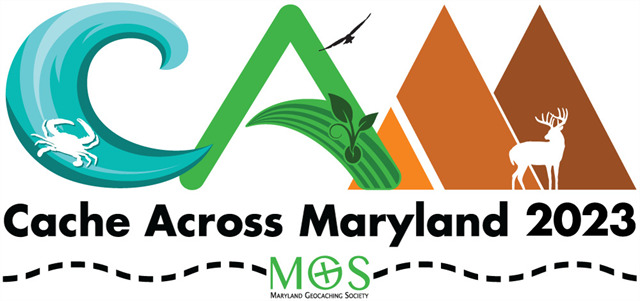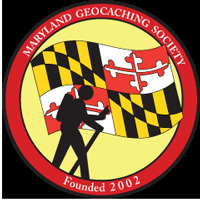
Welcome to Cache Across Maryland 2023. This year is the 20th anniversary of CAM. We have made this year a little special with a CAM cache in every county, plus Baltimore City.
This is one of the caches placed for Cache Across Maryland 2023. You must find a minimum of ten caches prior to the picnic held on Saturday, June 3, 2023 in order to receive a free Maryland Geocaching Society CAM geocoin.
Make note of the code word found inside each cache container. You must enter all the symbols into an online decoder in order to print your CAM certificate as well as print a claim form to submit and receive your geocoin at the picnic. More info on CAM is available here.
There are FIVE MANDATORY COUNTIES. THOSE WILL BE GARRETT, ST MARY'S, CECIL, WORCESTER AND ANNE ARUNDEL. You can choose any of the other five counties to find a minimum of ten CAM caches.
National Museum of Health and Medicine
This museum is on a United States Army Installation, and photography of the fence line or buildings behind the fence line is strictly prohibited! Geocachers should only take pictures of the museum and public galleries.
For the best museum experience, NMHM recommends using the free app located here, and click on the "Tours" section.
Welcome to Forest Glen, Maryland, home of The National Museum of Health and Medicine (NMHM). NMHM was established during the Civil War as the Army Medical Museum, a center for the collection of specimens and artifacts for research related to trauma and pathology. The museum's mission to preserve and explore the impact of military medicine spans more than 150 years and includes each major U.S. armed conflict. In 1862, in the midst of the American Civil War, US Army Surgeon General William Hammond established the Army Medical Museum to serve as a center for the collection of specimens for research in military medicine and surgery. Hammond directed medical officers in the field to collect "specimens of morbid anatomy together with projectiles and foreign bodies removed" and to forward them to the newly founded museum for study.

By World War II, research at the museum focused increasingly on pathology. In 1946, the museum became a division of the new Army Institute of Pathology (AIP), which developed into the world renowned Armed Forces Institute of Pathology (AFIP) in 1949. The museum's library and part of its archives were transferred to the National Library of Medicine when it was formed in 1956. The Army Medical Museum then became the Medical Museum of the AFIP in 1949, the Armed Forces Medical Museum in 1974, and the National Museum of Health and Medicine in 1989. The museum was located on the campus of the former Walter Reed Army Medical Center until 2011 at which time it moved to Silver Spring, Maryland and became part ofthe U.S. Army Medical Research and Materiel Command (now known as the U.S. Army Medical Research and Development Command). On August 23, 2015, the museum joined the Defense Health Agency as a division of the Research and Engineering Directorate. CONGRATS to WJFamily for FTF!!
The final stage is not located at the posted coordinates, which are the location of the museum. To get to the final stage, you will have to find eight items of interest within the museum. Each item has a number associated with it, enter the numbers into the following puzzle to get the final coordinates.
Puzzle:
Final : N 39° 0A.BCD W 077° 0E.FGH
“When you enter the museum, the front desk staff will greet you and give you a brief mandatory orientation to the layout of the museum of less than a minute’s duration, this is standard policy for all visitors. After your orientation, you might consider opening the museum app HERE which provides more details than the exhibits do. Straight in front of you in the lobby, are the Museum Seal, Beauchene Skeleton and “Noon” Painting of Forest Glen in 1944. Consider exploring more about these items in the App which has additional details of these items, but is not required to solve the puzzle.
First enter The Hall of Anatomy and Pathology to your right. Find the Brain and Spinal Cord from 1935. This is an actual preserved human specimen and is an excellent example of normal neuroanatomy. Traumatic Brain Injury was one of the most common injuries associated with the Conflict in Iraq. Blast Waves from explosions such as Improvised Explosive Devices, or even sports injuries like concussions can injure the brain subtly and result in neurologic or psychological symptoms later. Here you can explore historical and emerging technologies being deployed to serve both military and civilian communities to prevent TBI. Find the specimen number of the Brain and Spinal Cord. What is the fifth digit (found after the first .) this is letter A (NMHM 1987.A003.27)
Next Enter Hall 2. Look for the exhibit on Biomedical Engineering on your left as you enter. Find the Kolff-Brigham Artificial Kidney. Crush, bullet or Blast Injuries that damage muscle can cause Kidney Damage from the Myoglobin that is released with the injury, as can sepsis from infection associated with trauma. There is a nice video of the dialysis machine being used in the Korean War in the app. Find the specimen number of the Kolff-Brigham Kidney. What is the first number after the letter M-this is letter C. (M-C28.00069)
Turn to your left and walk towards the Elephantiasis leg. Before you get there look at the wall on your right, there are many pathologic specimens here. Take some time to explore the diseases shown. Now find specimen #14 The Trichobezoar. "Bezoar" comes from pad-zahr, a Persian word that means antidote. Middle Eastern and European physicians believed Bezoars to be a universal cure for poison as well as leprosy, measles, cholera and depression until debunked by French surgeon Ambroise Paré in 1575. Trichobezoar is a rare cause of stomach obstruction. Patients who have psychological disorders which predispose to hair pulling and or swallowing can develop trichobezoar. It usually requires surgery if it gets big enough to cause obstruction. There is an AFIP number in black on the specimen and on the description plate number 14. The first Digit of this number is letter F. (AFIP F126060)
Now check out the Elephantiasis leg in its own display case. Elephantiasis is a neglected tropical disease. It is caused by parasitic worm larva called microfilaria that invade the body and go into the lymph vessels and cause scarring. The damaged lymph vessels do not drain correctly and cause swelling called edema. This leg was amputated from a 27-year-old man in 1894 after 12 years suffering from this debilitating illness. On the plaque describing the elephantiasis leg there is an AFIP number. The second digit of this number is letter D. (AFIP 0D99186)
From the Elephantiasis Leg, move to the Exhibit Lincoln’s Final Hours. On April 14, 1865 President Abraham Lincoln was assassinated by John Wilkes Booth who shot the President in the head at close range using a .45 caliber deringer pistol. Two Physicians from NMHM Dr. JJ Woodward and Dr. Edward Curtis performed the autopsy. There are several interesting objects here including a lock of hair from the President’s head wound, Dr Curtis shirt sleeves stained with the president’s blood from the autopsy, bone fragments from the president’s skull and the bullet removed from his brain where it was found lodged behind the left eye. Find the Bullet that killed the president. It has a specimen number starting with M. The first digit of this number is letter G. (M-G81.00322)
Now move to the Civil War area across from the display on Chemical Warfare and the museum archives. Find the Display on Major General Daniel Sickles. On July 2nd 1863 on the second day of the Battle of Gettysburg, MG Sickles was wounded by a 12-pounder solid cannonball which shattered his R leg. He calmed his horse dismounted, and was taken to the rear where he underwent an above the knee amputation. By September he was able to ride again and donated his leg to the NMHM. He even returned later on the Anniversary of the Battle of Gettysburg to see his leg on exhibit. Find the specimen number for MG Sickles Shattered Tibia and Fibula. It starts with AFIP. The last digit of the number is letter B. (AFIP 037908B)
Now enter the Hall 3 Military Medicine Challenges and Innovations. Find the section of Floor from Trauma Bay II: Balad, Iraq 2003-2007. Because of advances in things like hemostatic dressings, tourniquets, surgical techniques, and blood product use, the survival rate for battle field casualties at Balad was 98%. This is even more remarkable in that trauma care was performed in a tent situated on top of this concrete pad, not a breick-and mortar hospital. Military Medical Lessons learned from Operation Iraqi Freedom are used in civilian Trauma care today including after the terror incident at the Boston Marathon in 2013 and in natural disaster events like tornados or multi-car accidents where mass trauma injuries can occur. Find the specimen number of the floor, it starts with a letter M. The 4th digit (after the .) is Letter H. (M-762.H0386)
Finally find the display dedicated to Walter Reed. There is a Zeiss Microscope he used to investigate typhoid fever. Typhoid is caused by a salmonella bacteria like in spoiled chicken or eggs except this bacteria can invade the bloodstream and also cause intestinal perforation. During the Spanish-American War (1898), typhoid killed more US soldiers than enemy bullets causing a scandal in the US press. Reed was tasked with finding the cause of this problem. Reed’s commission’s findings placed responsibility for the poor health of the troops directly on their military commander and implicated filth and flies in soldier’s food and berthing for transmission of typhoid fever, Reed also further developed the concept of asymptomatic typhoid carriers like the infamous Typhoid Mary. Find the collection number of the Microscope. The second digit of the number is Letter E. (M-0E0.00420
The final cache is found at
N 39° 0A.BCD W 077° 0E.FGH
There is a geochecker to confirm your final coordinates.
Access / Hours
- Hours of Operation
- Wednesday through Sunday
- 10 AM to 5:30 PM
- Admission is free but requires a Photo ID for all adult visitors
